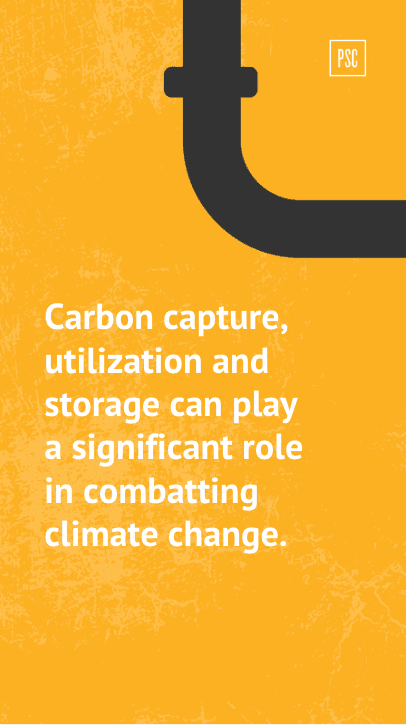The United States is aiming to hit net-zero carbon emissions by 2050. Carbon capture, utilization and storage (CCUS) technology can play a major role in reaching that goal. CCUS has the potential to significantly reduce greenhouse gas emissions and combat climate change, particularly in industrial and commercial sectors that are notoriously difficult to decarbonize. However, the widespread adoption of CCUS is up against several barriers, not the least of which are the need for an expanded land-based carbon dioxide (CO2) pipeline network and unique regulatory challenges. We recently examined the challenges — and possibilities — of this critical infrastructure.
The Power of Carbon Capture, Utilization and Storage
For CCUS to reduce CO2 emissions and ease the transition to a low-carbon economy, it must first isolate those emissions from industrial processes or power generation. Then, the captured CO2 is either used as raw material in another process, such as enhanced oil recovery, or permanently stored in underground reservoirs. Leveraging CCUS can reduce the environmental impact of continued fossil fuel use while making strides toward a cleaner energy future. This emerging technology shows signs of promising economic opportunities, including the development of new industries and job creation. It also plays a role in enhancing energy security by diversifying our energy sources. These are some of the reasons enabling CCUS has become a key objective of the Biden-Harris administration’s clean energy policy and has received bipartisan support.
Laying the Groundwork
It’s rare for CO2 to be reused or stored at the same place it is captured, so it needs to be transported from the source to a utilization or storage site. To achieve CO2 emissions targets by 2050, tens of thousands more miles of dedicated pipelines will be required. Current estimates range anywhere from a minimum of 29,000 to 66,000 pipeline miles. However, as of October 2022, there were fewer than 5,400 miles of CO2 pipelines in the U.S. This shortfall alone — and what it means for the prospect of moving large quantities of CO2 from point source to use or storage — threatens to stifle the development of CCUS projects and technologies before they get started. Thus inhibiting important tools in the effort to meet CO2 reduction goals.
More Barriers to Widespread CCUS Deployment
One of the main challenges to widespread deployment is the high cost and technical complexity associated with implementing and operating large-scale CCUS infrastructure. Compared to alternatives like solar photovoltaic technology, CCUS remains relatively expensive for CO2 emissions reduction. Additionally, the lack of readily available support, particularly at the state level, discourages investment in CCUS projects. Financial incentives and supportive policies like those already in place for solar photovoltaic development are inconsistent at best and often don’t exist at all.
Safe and secure underground storage of CO2 and the development of new carbon utilization technologies are also tricky. Deploying large-scale carbon capture systems in certain emissions-intensive industrial settings like mineral, natural gas, hydrogen and iron and steel production plants is still being explored. Though research and development efforts have led to increased CO2 capture rates and reductions in both capital and operating costs of capture systems, more work is needed to ensure these larger systems are efficient, cost-effective and scalable.
Lastly, public opposition to various aspects of CCUS technologies, including land-use challenges raised by property owners impacted by pipelines, concerns about extended reliance on fossil fuels and safety have contributed to decisions about relocating or canceling CCUS projects. Some people also have expressed concerns about CCUS infrastructure extending the timeline of safety risks and other environmental dangers posed by industrial facilities located in disadvantaged communities.
State Regulatory Requirements
Rerouting Regulatory Oversight
The current regulatory landscape surrounding CO2 pipeline development is, in a word, uncertain. While the U.S. Department of Transportation oversees safety regulation through the Pipeline and Hazardous Materials Safety Administration, the definition of CO2 in federal regulations has not been updated since 1991. This raises questions about the extent of PHMSA’s jurisdiction. The regulatory gap extends to economic oversight of CO2 pipelines, as regulatory bodies like the Federal Energy Regulatory Commission and Surface Transportation Board have declined jurisdiction over interstate CO2 pipelines.
Moreover, CO2 pipeline siting and permitting fall under the authority of state and local governments, leading to a maze of differing regulatory requirements. Other challenges include finding agreement on the definition of a common carrier pipeline, laws governing eminent domain authority and variations in pipeline regulations in different states. Inconsistencies and policy vacuums in CO2 pipeline laws leave local governments with sole siting authority over the sections within their boundaries, creating potential for legal challenges and a higher likelihood of regulatory differences from state to state.
What does eminent domain law mean for CCUS pipelines?
Eminent domain laws direct the process by which the government may take private property for infrastructure projects deemed in the public interest, often requiring fair market compensation for landowners. For example, this authority has been used to ensure energy companies can complete projects that move oil, gas and power to consumers. Currently, many states don’t have laws that directly address eminent domain for pipelines used to transport carbon dioxide, adding to the complexity for developers struggling to secure pipeline right of way across state lines.
To expand the CO2 pipeline network and facilitate CCUS deployment, these regulatory challenges must be addressed. That means updating federal definitions, clarifying jurisdictional oversight and fostering collaboration among state regulators for interstate CO2 pipeline projects. It is important that PHMSA leads the charge in collaboratively and swiftly updating safety standards and emergency response protocols. Protocols that should be consistent with modern business practices and the projected demand for pipeline infrastructure. Streamlined regulations, along with supportive policies and incentives, can encourage private investment and speed up the development of the CO2 pipeline infrastructure necessary to achieve U.S. climate goals.
What’s Coming Down the Pipe(line)
The uncertainty around CO2 pipeline regulation across all levels of government jeopardizes the development of an interconnected, accessible and nationwide CO2 pipeline network. In the absence of comprehensive federal rules, individual states are left to fill the void. The resulting patchwork of safety, environmental and economic regulation has encouraged pipeline development in some states but discouraged it in others. At best, these myriad laws increase the regulatory burden of building the thousands of miles of additional CO2 pipelines needed to support CCUS. At worst, they could be inadequate — both to protect public safety and to encourage the strategic development needed to transport ever-increasing amounts of captured CO2 in an environmentally and economically beneficial way. Collaboration among federal, state and local governments, industry stakeholders and the public is vital to ensure the regulatory framework fosters the expansion of the CO2 pipeline network, accelerates CCUS deployment and paves the way for a sustainable future.



